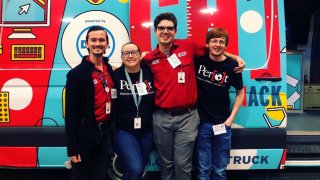
The Perot Museum TECH Truck is a mobile makerspace that inspires minds of all ages to bring out their inner scientist. Our team travels around North Texas to schools, libraries, hospitals, community events, colleges, festivals and pretty much anywhere an interactive truck can be hosted. The activities we facilitate focus on one or more of the elements of STEAM (science, technology, engineering, art, and mathematics). The mission of TECH Truck is to inspire learners of all ages to see their unique passions come to life in real time and inspire ideas that lead to groundbreaking updates and discoveries in sciences. The TECH Truck not only brings the Museum to our community, it also provides equal access to science and technology to underserved audiences. Last year alone, we engaged over 92,000 participants through our programs.
The TECH Truck team is made up of enthusiastic educators that have specializations in different fields, which is one of the components that make us successful and accessible. My background is a marriage of science and art – I got my undergrad in Zoology (the study of animals) and graphic and digital art. I was once the child that was inspired by science educators to pursue the path of wildlife sciences and a dream of mine has been to be someone who can continue that pursuit of inspiring others. Since then I have used my two passions together to combine technology and animal sciences. I’ve created visuals for zoo education to show the different physical adaptations of marine wildlife to explain how these characteristics make them successful as a species.
That being said, the whole world around us is a great motivation for new ideas and thought processes, which leads me to a topic I often draw and teach about – biomimicry. Biomimicry is the art of looking to nature and its processes to gain ideas or policies that can solve human problems big and small. We can thank biomimicry for the invention of airplanes, cars, boats, and even some robots. For example, in the late 1990s, bullet trains in Japan faced an issue of creating large booming sounds as they went through tunnels. This disturbed local communities that lived nearby and even wildlife. Not only were they loud, but the built-up air also caused drag, resulting in slower trains. Fortunately, one of the engineers of the bullet trains was a bird watcher who had observed a species of kingfisher, a family of birds with large heads and triangular beaks that dive at high speeds into the water for its prey without creating much of a splash. He studied the shape of the beak of the kingfisher which had a rounded narrow tip that pierced the water causing the water to flow more steadily around it. This observation inspired his team to successfully remodel the bullet trains, changing the shape of the train’s head to mimic the kingfisher to successfully solve this sound and lag issue.
When people think of “science,” the term “artwork” or “design” may not come to mind. We may not think of art being an element of science, but it most certainly is. Artists are vital in the world of science and some scientific theories cannot be communicated without an artist’s rendering. Renderings include but are not limited to designs, models, and other elements to help scientists understand the world. A great tool used by graphic artists is a Wacom tablet which can be mastered at a TECH Truck museum program. This tablet is an electronic sketchbook with a pen that can be programed to be anything you want it to be. For example, with our activities you can use these pens to be paint brushes where you can color templates that I created. It’s a great way to introduce how a Wacom tablet is used.
The Wacom tablet isn’t only beneficial for drawing or painting. It can be used for 3D modeling, architecture, engineering, animation, and biological models. If you have visited the Perot Museum, you might have come across many forms of artwork used to teach or visualize a specific concept. Many models of fossils or other models can be created in a 3D modeling software to replicate a specific subject. Graphic art is widely used by paleontologists to help us visualize how dinosaurs and other extinct animals looked like or how they behaved. If you look at early inventors like Leonardo da Vinci or Galileo Galilei, you’ll see that these scientists used drawings and artwork to articulate and convey their discoveries.
No matter what inspires you, you can bring all kinds of unique ideas to the science community. TECH Truck is a great way to expose yourself to new things that you may not normally get to experience. Whether you’re artistic, logical, math-minded, a tinkerer; you can be a scientist. Every day is an opportunity to learn something new and to introduce yourself to a newfound interest. Bringing our mobile learning facility to your community just might awaken new inventors that can change the world. For more information on how to book the TECH Truck for your event, visit www.perotmuseum.org/techtruck.

